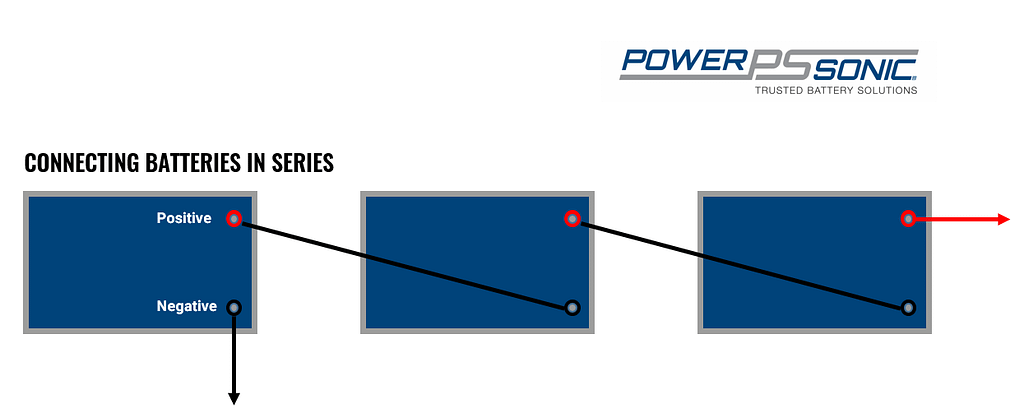If you have ever worked with batteries you have probably come across the terms series, parallel, and series-parallel, but what exactly do these terms mean?
Series, Series-Parallel, and Parallel is the act of connecting two batteries together, but why would you want to connect two or more batteries together in the first place?
By connecting two or more batteries in either series, series-parallel, or parallel, you can increase the voltage or amp-hour capacity, or even both; allowing for higher voltage applications or power hungry applications.
CONNECTING BATTERIES IN SERIES
Connecting a battery in series is when you connect two or more batteries together to increase the battery systems overall voltage, connecting batteries in series does not increase the capacity only the voltage.
For example if you connect four 12Volt 26Ah batteries you will have a battery voltage of 48Volts and battery capacity of 26Ah.
To configure batteries with a series connection each battery must have the same voltage and capacity rating, or you can potentially damage the batteries. For example you can connect two 6Volt 10Ah batteries together in series but you cannot connect one 6V 10Ah battery with one 12V 20Ah battery.
To connect a group of batteries in series you connect the negative terminal of one battery to the positive terminal of another and so on until all batteries are connected. You would then connect a link/cable to the negative terminal of the first battery in your string of batteries to your application, then another cable to the positive terminal of the last battery in your string to your application.
When charging batteries in series, you need to use a charger that matches the battery system voltage. We recommend you charge each battery individually to avoid battery imbalance.
Sealed lead acid batteries have been the battery of choice for long string, high voltage battery systems for many years, although lithium batteries can be configured in series, it requires attention to the BMS or PCM.

CONNECTING BATTERIES IN PARALLEL
Connecting a battery in parallel is when you connect two or more batteries together to increase the amp-hour capacity. With a parallel battery connection the capacity will increase, however the battery voltage will remain the same.
Batteries connected in parallel must be of the same voltage, i.e. a 12V battery can not be connected in parallel with a 6V battery. It is best to also use batteries of the same capacity when using parallel connections.
For example, if you connect four 12V 100Ah batteries in parallel, you would get a 12V 400Ah battery system.
When connecting batteries in parallel, the negative terminal of one battery is connected to the negative terminal of the next and so on through the string of batteries. The same is done with positive terminals, i.e. the positive terminal of one battery to the positive terminal of the next.
For example, let’s say you needed a 12V 300Ah battery system. You will need to connect three 12V 100Ah batteries together in parallel.
Parallel battery configuration helps increase the duration in which batteries can power equipment, but due to the increased amp-hour capacity they can take longer to charge than series connected batteries. This time can safely be reduced, without damaging the batteries, by charging faster. Now that the battery is larger, a higher current charge is still the same percentage of the total capacity, and each battery ‘feels’ a smaller current.

While it is often debated what the best way to connect in parallel is, the above method is common for low current applications. For high current applications, talk to one of our experts as your situation may need a special configuration to ensure all of the batteries age at as similar as possible rates.
SERIES – PARALLEL CONNECTED BATTERIES
Last but not least! There is series-parallel connected batteries. Series-parallel connection is when you connect a string of batteries to increase both the voltage and capacity of the battery system.
For example, you can connect six 6V 100Ah batteries together to give you a 12V 300Ah battery, this is achieved by configuring three strings of two batteries.
In this connection you will have two or more sets of batteries which will be configured in both series and parallel to increase the system capacity.

If you need any help with configuring batteries in series, parallel or series parallel please get in contact with one of our battery experts.







